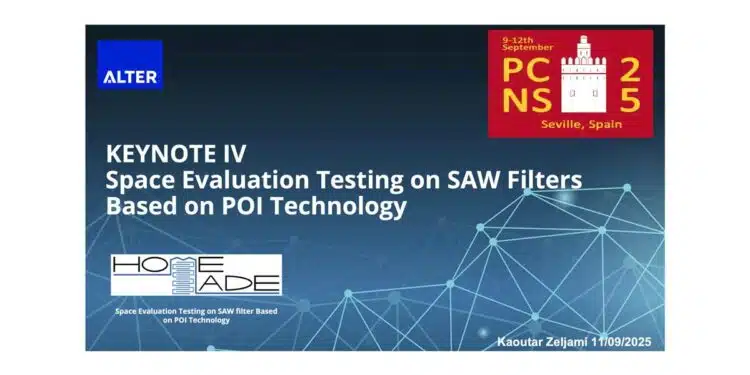The paper “Space Evaluation Testing on SAW Filter Based on POI Technology” was presented by Kaoutar Zeljami, ALTER Technology TÜV NORD, Sevilla, Spain at the 5th PCNS Passive Components Networking Symposium 9-12th September 2025, Seville, Spain as Keynote IV paper.
Introduction
The study focuses on the evaluation of Surface Acoustic Wave (SAW) filters based on Piezo-On-Insulator (POI) technology for potential use in space applications, particularly in L-band GPS systems.
The research is part of the HOMEMADE project, which aims to equip the European space industry with low-cost, high-performance SAW filters suitable for 5G direct satellite connectivity. SAW filters are essential in enabling high-quality factor RF performance while minimizing satellite size and weight.
The evaluation is a critical step in determining the technology’s robustness and reliability under harsh environmental conditions.
Key Points
- SAW filters with POI substrate offer high integration, thermal stability, low insertion loss, and strong rejection.
- Evaluation tests were based on ESCC 2263502 and ESCC 3502 standards.
- Testing included constructional analysis, temperature and power step-stress tests, life tests, thermal cycling, and humidity assessment.
- Devices demonstrated strong environmental resilience with minor deviations related to the die attach process.
- Post-process annealing is critical for long-term stability of the filters.
Extended Summary
The evaluation involved 3.8SQ hermetic L-band GPS SAW filters developed within the HOMEMADE project by SOITEC. The devices were mounted on dedicated RO4350B test boards with 50-ohm grounded coplanar waveguides and SMA connectors for electrical measurements up to 18 GHz. Before soldering, filters were baked at 125ºC for 24 hours and soldered using a SnPb reflow profile with a peak of 235ºC.
The test campaign began with a thorough constructional analysis. Visual inspections, PIND, gross leak tests, and SEM analysis showed that the devices had no visible defects or contaminations. Bond pull tests were successful, but die shear tests revealed some failures in three samples, linked to die attachment rather than the POI technology itself. Slight wedge bond separations were observed, and material analysis confirmed compliance with space material restrictions.
Temperature step-stress tests determined the filters could reliably operate up to 105ºC without performance degradation, while power step-stress tests confirmed that the devices could handle up to +10 dBm with no electrical drift or internal structural damage to the interdigital transducers (IDTs). SEM inspections after testing confirmed IDT integrity.
Steady-state accelerated life tests were carried out at 105ºC with a -10 dBm RF signal for up to 1000 hours. Results demonstrated minimal passband drift (approximately 2 MHz) in the worst-case sample, linked to the omission of a post front-end annealing process. Complementary samples confirmed that a 250ºC annealing step is essential to stabilize Al-Cu electrodes.
Additional tests included low-temperature life testing at -55ºC for 1000 hours, which showed no anomalies, and thermal cycling between -55ºC and 125ºC for 100 cycles. Follow-up humidity testing at +85ºC and 85% RH revealed no electrical performance changes. The final thermal cycling and visual inspections confirmed the filters’ durability.
Overall, the evaluation demonstrated that POI-based SAW filters are robust and suitable for space applications. Detected deviations were attributed to assembly processes and can be mitigated through improved die attachment and post-annealing steps.
Conclusion
The extended evaluation of L-band GPS SAW filters based on POI substrates validates their potential for use in space environments, meeting the stringent requirements for 5G direct satellite connectivity. The filters showed resilience to thermal, power, and environmental stress tests, with only minor improvements needed in assembly processes to achieve full compliance with ESCC and MIL-STD standards. These findings support the continuation toward space qualification and the integration of POI-based SAW filters into future satellite constellations.
































